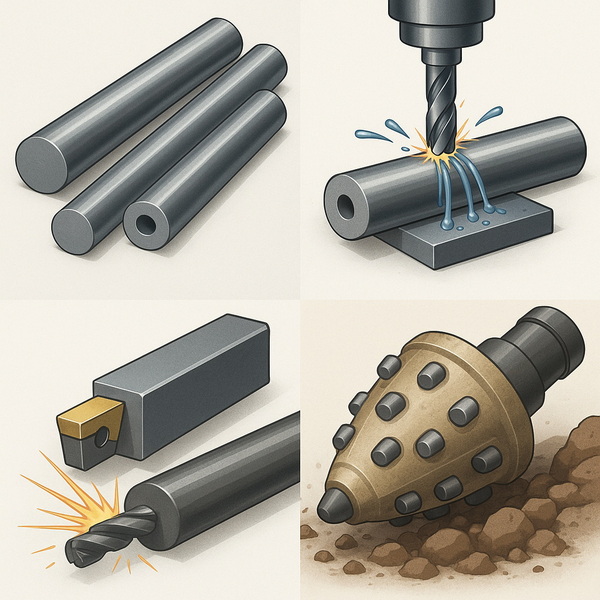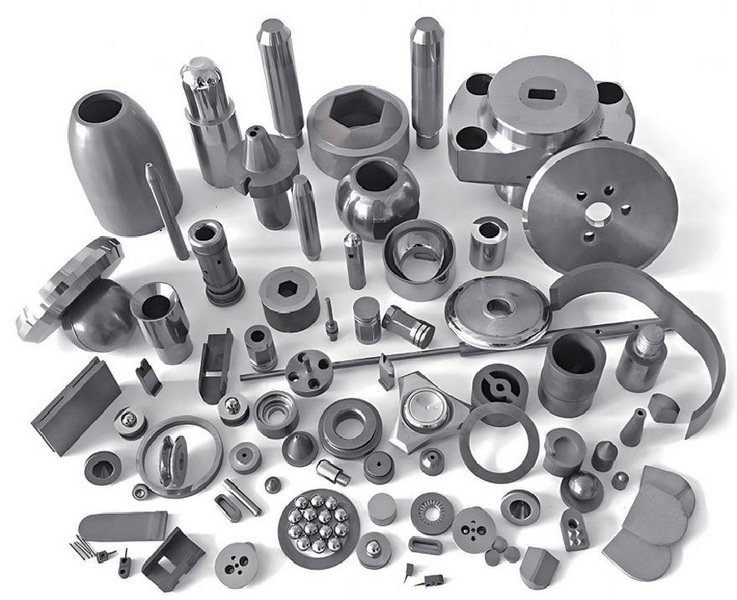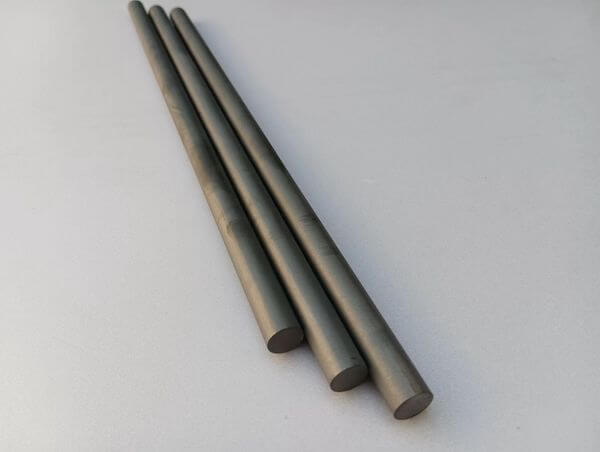Content Menu
● Introduction to Tungsten Carbide Rods
● Composition and Material Properties
>> Chemical Composition
>> Physical Properties
● Manufacturing Process
● Types and Grades of Tungsten Carbide Rods
>> Types
>> Grades
● Key Applications Across Industries
>> Cutting Tools
>> Mining and Construction
>> Wear Parts
>> Aerospace and Automotive
>> Medical and Dental Tools
>> Other Applications
● Advantages Over Traditional Materials
● How to Select the Right Tungsten Carbide Rod
● Maintenance and Handling Tips
● Environmental Impact and Sustainability
● Innovations and Future Trends
● Historical Development of Tungsten Carbide Rods
● Impact on Industry and Economy
● Summary of Key Points
● Conclusion
● FAQ
>> 1. What are the main differences between tungsten carbide rods and steel rods?
>> 2. Can tungsten carbide rods be customized for specific applications?
>> 3. How are tungsten carbide rods typically manufactured?
>> 4. What industries benefit most from using tungsten carbide rods?
>> 5. How should tungsten carbide rods be handled and maintained?
Tungsten carbide rods are essential components in modern industry, renowned for their remarkable hardness, strength, and resistance to wear and heat. These cylindrical bars, crafted from a composite material of tungsten carbide and a metallic binder (typically cobalt), play a pivotal role in the manufacturing of cutting tools, wear parts, and precision machinery. This article explores the science, manufacturing process, applications, advantages, and selection criteria of tungsten carbide rods, offering a comprehensive guide for engineers, manufacturers, and anyone interested in advanced materials.

Introduction to Tungsten Carbide Rods
Tungsten carbide rods, often referred to as carbide rods, are cylindrical bars produced from a composite material called tungsten carbide. This material is a combination of tungsten and carbon atoms, fused together to form an extremely hard and durable substance. The rods are further strengthened by adding a metallic binder, usually cobalt, which enhances their toughness and resilience.
Tungsten carbide rods are the backbone of high-performance cutting tools, drill bits, end mills, and wear-resistant parts used in sectors ranging from metalworking and mining to aerospace and medical equipment. Their unique balance of hardness and toughness makes them indispensable wherever durability and precision are paramount.
Composition and Material Properties
Chemical Composition
Tungsten carbide rods are primarily composed of:
- Tungsten carbide (WC): The main phase, providing extreme hardness.
- Cobalt (Co): Acts as a binder, imparting toughness and impact resistance.
- Trace elements: Sometimes nickel, titanium, or tantalum are added to tailor specific properties.
Physical Properties
| Property | Value/Characteristic |
| Hardness | 85–95 HRA (Rockwell Hardness) |
| Compressive Strength | Up to 2.7 GPa |
| Young's Modulus | 530–700 GPa |
| Density | 14.5–15.1 g/cm³ |
| Thermal Conductivity | 110 W/(m·K) |
| Melting Point | 2,870°C |
| Wear Resistance | Extremely high |
| Corrosion Resistance | Excellent, especially with proper binder selection |
These properties make tungsten carbide rods capable of withstanding extreme mechanical and thermal stress without deformation, chipping, or excessive wear.
Manufacturing Process
The production of tungsten carbide rods is a sophisticated process involving powder metallurgy and advanced sintering techniques. Here's an overview:
1. Powder Preparation: Tungsten and carbon powders are precisely measured and mixed, often with cobalt powder as a binder.
2. Wet Milling: The mixture is milled to achieve uniform particle size and distribution.
3. Drying and Sieving: The slurry is dried and sieved to ensure consistency.
4. Granulation: A forming agent is added, and the mixture is granulated to improve pressing characteristics.
5. Pressing/Forming: The granulated powder is pressed into cylindrical shapes using one of several methods:
- Die pressing (most common)
- Extrusion pressing
- Isostatic pressing (for larger diameters)
6. Sintering: The pressed rods are heated in a vacuum or controlled atmosphere at high temperatures, causing the powder particles to fuse into a dense, solid structure.
7. Post-Sintering Processing: Includes straightening, grinding, and polishing to achieve precise dimensions and surface finish.
Types and Grades of Tungsten Carbide Rods
Tungsten carbide rods are available in a variety of types and grades, each tailored for specific applications:
Types
- Solid rods: Standard cylindrical rods without holes, used for most cutting tools.
- Rods with straight holes: Designed for coolant flow in high-speed machining.
- Rods with helical holes: For advanced cooling and chip removal.
- Customized shapes: Including chamfered ends, stepped rods, and more.
Grades
The grade of a tungsten carbide rod is determined by the ratio of tungsten carbide to cobalt, grain size, and the presence of any alloying elements. Common grades include:
| Grade | WC (%) | Co (%) | Grain Size | Application |
| Fine Grain | 94 | 6 | <1 μm | Finishing tools, high precision |
| Medium Grain | 92 | 8 | 1–2 μm | General-purpose cutting tools |
| Coarse Grain | 89 | 11 | >2 μm | Heavy-duty, impact-resistant tools |
Key Applications Across Industries
Tungsten carbide rods are integral to a wide range of industries due to their superior material properties:
Cutting Tools
- End mills
- Drill bits
- Reamers
- Rotary burrs
- Saw blades
These tools benefit from the rods' hardness and wear resistance, enabling high-speed machining and extended tool life.
Mining and Construction
- Rock drilling tools
- Crusher components
- Tunnel boring machine parts
Their ability to withstand harsh geological conditions and abrasive environments makes tungsten carbide rods indispensable in mining and construction.
Wear Parts
- Bearings
- Valve seats
- Nozzles
- Pump components
These parts require exceptional resistance to abrasion, corrosion, and thermal stress.
Aerospace and Automotive
- Precision components
- Measuring tools
- Aviation tooling
Reliability and performance under extreme conditions are critical in these sectors.
Medical and Dental Tools
- Bone cutters
- Dental burs
- Surgical instruments
Precision and durability are essential for medical applications.
Other Applications
- Papermaking and printing tools
- Electronic and telecommunication equipment
- Oil and gas industry components

Advantages Over Traditional Materials
Tungsten carbide rods offer several distinct advantages compared to traditional tool steels and alloys:
- Superior Hardness: Second only to diamond, enabling cutting and machining of the hardest materials.
- Exceptional Wear Resistance: Prolongs tool life and reduces maintenance.
- High Thermal Stability: Maintains hardness and strength at elevated temperatures.
- Corrosion Resistance: Withstands exposure to chemicals and moisture.
- Cost Efficiency: Longer tool lifespans reduce replacement and downtime costs.
- Versatility: Suitable for a broad range of applications and customizable for specific needs.
How to Select the Right Tungsten Carbide Rod
Choosing the right tungsten carbide rod depends on several factors:
- Application: Define whether the rod will be used for cutting, drilling, wear parts, or another purpose.
- Grade Selection: Match the grade to the required hardness, toughness, and wear resistance.
- Dimensions: Ensure the rod meets the size and tolerance requirements of your application.
- Coolant Requirements: For high-speed machining, consider rods with coolant holes.
- Supplier Quality: Source from reputable manufacturers who guarantee consistent material properties and quality control.
Maintenance and Handling Tips
To maximize the lifespan and performance of tungsten carbide rods:
- Handle with care: Despite their hardness, carbide rods can be brittle and susceptible to chipping if dropped.
- Store properly: Keep rods in dry, clean environments to avoid contamination.
- Use appropriate cutting tools: When machining carbide rods, use diamond or CBN tools to prevent excessive wear.
- Regular inspection: Check for cracks, chips, or excessive wear before use.
Environmental Impact and Sustainability
As industries increasingly focus on sustainability, the environmental impact of tungsten carbide rods is gaining attention. The production process involves energy-intensive steps such as sintering at high temperatures, which contributes to carbon emissions. However, the long lifespan and durability of tungsten carbide rods reduce the frequency of replacements, thereby lowering overall material consumption and waste.
Recycling programs for tungsten carbide scrap are well-established, allowing manufacturers to recover and reuse valuable materials. This recycling not only conserves natural resources but also reduces the environmental footprint of tungsten carbide products.
Innovations and Future Trends
The field of tungsten carbide rods continues to evolve with ongoing research and development. Innovations include the development of nano-grain tungsten carbide materials, which offer enhanced hardness and toughness. Additionally, new binder materials are being explored to improve corrosion resistance and reduce brittleness.
Additive manufacturing techniques, such as 3D printing of tungsten carbide composites, are emerging, potentially enabling more complex shapes and customized designs with reduced waste.
These advancements promise to expand the applications and performance of tungsten carbide rods in the future.
Historical Development of Tungsten Carbide Rods
The development of tungsten carbide rods dates back to the early 20th century when the need for harder and more durable materials in industrial applications became apparent. The discovery of tungsten carbide as a material with exceptional hardness revolutionized tool manufacturing. Early tungsten carbide rods were primarily used in cutting tools for metalworking, replacing traditional high-speed steels.
Over the decades, advancements in powder metallurgy and sintering technology have significantly improved the quality and performance of tungsten carbide rods. Innovations such as the introduction of cobalt binders and the refinement of grain sizes have allowed for the production of rods with tailored properties for specific applications.
Today, tungsten carbide rods are a cornerstone of modern manufacturing, enabling precision machining and high-speed cutting that were previously impossible.
Impact on Industry and Economy
The introduction of tungsten carbide rods has had a profound impact on various industries by enhancing productivity and reducing costs. Their durability and wear resistance have extended the lifespan of cutting tools and wear parts, minimizing downtime and maintenance expenses.
In sectors such as automotive manufacturing, aerospace, and mining, tungsten carbide rods have enabled the production of complex components with high precision and reliability. This has contributed to advancements in technology and the overall growth of these industries.
Moreover, the ability to recycle tungsten carbide materials has created economic opportunities in the recycling sector, promoting sustainable practices and resource efficiency.
Summary of Key Points
- Tungsten carbide rods are composed mainly of tungsten carbide and cobalt binder.
- They exhibit exceptional hardness, wear resistance, and thermal stability.
- Manufacturing involves powder metallurgy and sintering processes.
- Available in various types and grades tailored for specific applications.
- Widely used in cutting tools, mining, wear parts, aerospace, and medical fields.
- Offer significant advantages over traditional materials.
- Proper selection, handling, and maintenance are crucial for optimal performance.
- Environmental sustainability and technological innovations are shaping the future of tungsten carbide rods.
- Their historical development and economic impact have been transformative for global industry.
Conclusion
Tungsten carbide rods have revolutionized modern manufacturing and engineering with their unmatched combination of hardness, strength, and resistance to wear and heat. Whether used in cutting tools, mining equipment, or precision medical instruments, these rods deliver reliability and performance in the most demanding environments. Understanding their properties, manufacturing process, and application-specific selection criteria ensures optimal results and cost efficiency for any industry. As technology and sustainability efforts advance, tungsten carbide rods will continue to play a critical role in shaping the future of industrial production.

FAQ
1. What are the main differences between tungsten carbide rods and steel rods?
Tungsten carbide rods are significantly harder and more wear-resistant than steel rods. They maintain their hardness at high temperatures, making them ideal for high-speed machining and abrasive environments. Steel rods, while tougher and less brittle, wear out faster and are less suitable for precision cutting applications.
2. Can tungsten carbide rods be customized for specific applications?
Yes, tungsten carbide rods can be manufactured in various sizes, shapes, and grades. Customizations include adding straight or helical coolant holes, chamfered ends, or specific surface finishes to meet unique application requirements.
3. How are tungsten carbide rods typically manufactured?
The process involves blending tungsten and carbon powders with a binder (usually cobalt), followed by pressing, sintering at high temperatures, and post-processing steps such as grinding and polishing. Advanced techniques like isostatic pressing are used for larger or more complex rods.
4. What industries benefit most from using tungsten carbide rods?
Industries such as metalworking, mining, construction, aerospace, automotive, oil and gas, and medical device manufacturing all benefit from the superior properties of tungsten carbide rods, particularly where durability, precision, and resistance to extreme conditions are required.
5. How should tungsten carbide rods be handled and maintained?
Handle with care to avoid chipping or breakage, store in clean and dry conditions, use appropriate cutting tools for machining, and inspect regularly for signs of damage or wear to ensure optimal performance and safety.
















